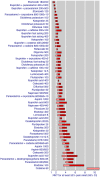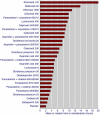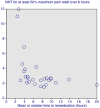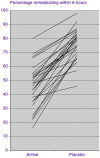Single dose oral analgesics for acute postoperative pain in adults - an overview of Cochrane reviews
- PMID: 26414123
- PMCID: PMC6485441
- DOI: 10.1002/14651858.CD008659.pub3
Single dose oral analgesics for acute postoperative pain in adults - an overview of Cochrane reviews
Abstract
Background: This is an updated version of the original Cochrane overview published in Issue 9, 2011. That overview considered both efficacy and adverse events, but adverse events are now dealt with in a separate overview.Thirty-nine Cochrane reviews of randomised trials have examined the analgesic efficacy of individual drug interventions in acute postoperative pain. This overview brings together the results of those individual reviews and assesses the reliability of available data.
Objectives: To summarise the efficacy of pharmaceutical interventions for acute pain in adults with at least moderate pain following surgery who have been given a single dose of oral analgesic.
Methods: We identified systematic reviews in the Cochrane Database of Systematic Reviews in The Cochrane Library through a simple search strategy. All reviews were overseen by a single review group, had a standard title, and had as their primary outcome the number of participants with at least 50% pain relief over four to six hours compared with placebo. For individual reviews, we extracted the number needed to treat for an additional beneficial outcome (NNT) for this outcome for each drug/dose combination, and also the percentage of participants achieving at least 50% maximum pain relief, the mean of mean or median time to remedication, and the percentage of participants remedicating by six, eight, 12, or 24 hours. Where there was adequate information for pairs of drug and dose (at least 200 participants, in at least two studies), we defined the addition of four comparisons of typical size (400 participants in total) with zero effect as making the result potentially subject to publication bias and therefore unreliable.
Main results: The overview included 39 separate Cochrane Reviews with 41 analyses of single dose oral analgesics tested in acute postoperative pain models, with results from about 50,000 participants in approximately 460 individual studies. The individual reviews included only high-quality trials of standardised design, methods, and efficacy outcome reporting. No statistical comparison was undertaken.Reliable results (high quality information) were obtained for 53 pairs of drug and dose in painful postsurgical conditions; these included various fixed dose combinations, and fast acting formulations of some analgesics. NNTs varied from about 1.5 to 20 for at least 50% maximum pain relief over four to six hours compared with placebo. The proportion of participants achieving this level of benefit varied from about 30% to over 70%, and the time to remedication varied from two hours (placebo) to over 20 hours. Good (low) NNTs were obtained with ibuprofen 200 mg plus paracetamol (acetaminophen) 500 mg (NNT compared with placebo 1.6; 95% confidence interval 1.5 to 1.8), ibuprofen fast acting 200 mg (2.1; 1.9 to 2.3); ibuprofen 200 mg plus caffeine 100 mg (2.1; 1.9 to 3.1), diclofenac potassium 50 mg (2.1; 1.9 to 2.5), and etoricoxib 120 mg (1.8; 1.7 to 2.0). For comparison, ibuprofen acid 400 mg had an NNT of 2.5 (2.4 to 2.6). Not all participants had good pain relief and, for many pairs of drug and dose, 50% or more did not achieve at least 50% maximum pain relief over four to six hours.Long duration of action (eight hours or greater) was found for etoricoxib 120 mg, diflunisal 500 mg, paracetamol 650 mg plus oxycodone 10 mg, naproxen 500/550 mg, celecoxib 400 mg, and ibuprofen 400 mg plus paracetamol 1000 mg.There was no evidence of analgesic effect for aceclofenac 150 mg, aspirin 500 mg, and oxycodone 5 mg (low quality evidence). No trial data were available in reviews of acemetacin, meloxicam, nabumetone, nefopam, sulindac, tenoxicam, and tiaprofenic acid. Inadequate amounts of data were available for nine drugs and doses, and data potentially susceptible to publication bias for 13 drugs and doses (very low quality evidence).
Authors' conclusions: There is a wealth of reliable evidence on the analgesic efficacy of single dose oral analgesics. Fast acting formulations and fixed dose combinations of analgesics can produce good and often long-lasting analgesia at relatively low doses. There is also important information on drugs for which there are no data, inadequate data, or where results are unreliable due to susceptibility to publication bias. This should inform choices by professionals and consumers.
Conflict of interest statement
RAM has no conflicts relating to this review or any similar product.
SD has no conflicts relating to this review or any similar product.
DA has no conflicts relating to this review or any similar product.
PJW has no conflicts relating to this review or any similar product.
We are funded by the NIHR for work on a series of reviews informing the unmet need of chronic pain and providing the evidence for treatments of pain but this review is not supported by that funding.
This review was identified in a 2019 audit as not meeting the current definition of the Cochrane Commercial Sponsorship policy. At the time of its publication it was compliant with the interpretation of the existing policy. As with all reviews, new and updated, at update this review will be revised according to 2020 policy update.
Figures





Update of
-
Single dose oral analgesics for acute postoperative pain in adults.Cochrane Database Syst Rev. 2011 Sep 7;(9):CD008659. doi: 10.1002/14651858.CD008659.pub2. Cochrane Database Syst Rev. 2011. Update in: Cochrane Database Syst Rev. 2015 Sep 28;(9):CD008659. doi: 10.1002/14651858.CD008659.pub3. PMID: 21901726 Free PMC article. Updated.
Comment in
-
Reliable evidence for efficacy of single dose oral analgesics.Evid Based Dent. 2016 Jun;17(2):60-1. doi: 10.1038/sj.ebd.6401175. Evid Based Dent. 2016. PMID: 27339244
References
References to included reviews
Aceclofenac 2009
Acemetacin 2009
Aspirin 2012
Celecoxib 2013
Codeine 2010
Dexibuprofen 2009
Diclofenac 2015
Diflunisal 2010
Dihydrocodeine 2000
Dipyrone 2010
Etodolac 2009
Etoricoxib 2014
Fenbufen 2009
Fenoprofen 2011
Flurbiprofen 2009
Gabapentin 2010
Ibuprofen + caffeine 2015
Ibuprofen + codeine 2015
Ibuprofen + oxycodone 2013
Ibuprofen + paracetamol 2013
Ibuprofen 2009
Indometacin 2004
Ketoprofen and dexketoprofen 2009
Lornoxicam 2009
Lumiracoxib 2010
Mefenamic acid 2011
Meloxicam 2009
Nabumetone 2009
Naproxen 2009
Nefopam 2009
Paracetamol + codeine 2009
Paracetamol 2008
Paracetamol ± dextropropoxyphene 1999
Paracetamol ± oxycodone 2009
Piroxicam 2000
Rofecoxib 2009
Sulindac 2009
Tenoxicam 2009
Additional references
Barden 2004
Barden 2006
-
- Barden J, Derry S, McQuay HJ, Moore RA. Bias from industry trial funding? A framework, a suggested approach, and a negative result. Pain 2006;121(3):207‐18. [DOI: ] - PubMed
Beecher 1957
-
- Beecher HK. The measurement of pain; prototype for the quantitative study of subjective responses. Pharmacology Reviews 1957;9:59‐209. - PubMed
Botting 2000
Caldwell 2005
Chandrasekharan 2002
-
- Chandrasekharan NV. COX‐3, a cyclooxygenase‐1 variant inhibited by acetaminophen and other analgesic/antipyretic drugs: cloning, structure and expression. Proceedings of the National Academy of Sciences of the United States of America 2002;99:13926‐31. [DOI: 10.1073/pnas.162468699] - DOI - PMC - PubMed
Collins 1997
Edwards 1999
Edwards 2002
FitzGerald 2001
Flower 1972
-
- Flower RJ, Vane JR. Inhibition of prostaglandin synthetase in brain explains the anti‐pyretic activity of paracetamol (4‐acetamidophenol). Nature 1972;240:410‐1. - PubMed
Frampton 2009
-
- Frampton C, Quinlan J. Evidence for the use of non‐steroidal anti‐inflammatory drugs for acute pain in the post anaesthesia care unit. Journal of Perioperative Practice 2009;19(12):418‐23. [PUBMED: 20225733] - PubMed
Glenny 2005
-
- Glenny AM, Altman DG, Song F, Sakarovitch C, Deeks JJ, D'Amico R, et al. International Stroke Trial Collaborative Group. Indirect comparisons of competing interventions. Health Technology Assessment 2005;9(26):1‐134, iii‐iv. - PubMed
Graham 2005
-
- Graham GG, Scott KF. Mechanism of action of paracetamol. American Journal of Therapeutics 2005;12(1):46‐55. [PUBMED: 15662292] - PubMed
Hawkey 1999
Hinz 2008
Houde 1960
-
- Houde RW, Wallenstein Sl, Rogers A. Clinical pharmacology of analgesics. 1. A method of assaying analgesic effect. Clinical Pharmacology and Therapeutics 1960;1:163‐74. [PUBMED: 14403344] - PubMed
Keats 1950
-
- Keats AS, Beecher HK, Mosteller FC. Measurement of pathological pain in distinction to experimental pain. Journal of Applied Physiology 1950;3(1):35‐44. [PUBMED: 14774320] - PubMed
Kehlet 1998
McQuay 1997
McQuay 2005
McQuay 2006
-
- McQuay HJ, Moore A. Methods of therapeutic trials. In: McMahon SB, Koltzenburg M editor(s). Textbook of Pain. 5. Churchill Livingstone, 2006:415‐26.
McQuay 2007
McQuay 2012
Mhuircheartaigh 2009
Moore 1996
Moore 1997a
Moore 1997b
Moore 1997c
Moore 1998
Moore 2003
-
- Moore RA, Edwards J, Barden J, McQuay HJ. Bandolier's Little Book of Pain. Oxford: Oxford University Press, 2003. [DOI: ]
Moore 2005
Moore 2006
-
- Moore A, McQuay H. Bandolier's Little Book of Making Sense of the Medical Evidence. Oxford: Oxford University Press, 2006. [ISBN: 0‐19‐856604‐2]
Moore 2008
-
- Moore RA, Barden J, Derry S, McQuay HJ. Managing potential publication bias. In: McQuay HJ, Kalso E, Moore RA editor(s). Systematic Reviews in Pain Research: Methodology Refined. Seattle: IASP Press, 2008:15‐23. [ISBN: 978‐0‐931092‐69‐5]
Moore 2011b
-
- Moore RA, Straube S, Paine J, Derry S, McQuay HJ. Minimum efficacy criteria for comparisons between treatments using individual patient meta‐analysis of acute pain trials: examples of etoricoxib, paracetamol, ibuprofen, and ibuprofen/paracetamol combinations after third molar extraction. Pain 2011;152(5):982‐9. [DOI: 10.1016/j.pain.2010.11.030] - DOI - PubMed
Moore 2013
Moore 2014
Moore 2015a
Moore 2015b
Moore 2015c
Moore 2015d
Pasternak 2012
PIC 2008
-
- Paracetamol Information Centre. www2.pharmweb.net/pwmirror/pwy/paracetamol/pharmwebpic.html (accessed 21 May 2015).
Salanti 2008
Schwab 2003
Shea 2007
Song 2003
Thornton 2000
Tramer 1998
-
- Tramèr MR, Williams JE, Carroll D, Wiffen PJ, Moore RA, McQuay HJ. Comparing analgesic efficacy of non‐steroidal anti‐inflammatory drugs given by different routes in acute and chronic pain: a qualitative systematic review. Acta Anaesthesiologica Scandinavica 1998;42(1):71‐9. [PUBMED: 9527748] - PubMed
WHO 2010
-
- World Health Organization. Pain ladder. www.who.int/cancer/palliative/painladder/en/ (accessed 21 May 2015).
Publication types
MeSH terms
Substances
LinkOut - more resources
Full Text Sources
Other Literature Sources
Medical

